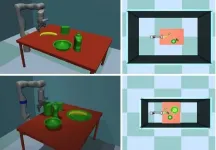(Press-News.org) Like a good story, feeding has a beginning, a middle and an end. It begins with appetite prompting the search for food, continues with eating the food and it ends when satiation hits and the consumption of food is stopped.
At Baylor College of Medicine, Dr. Qi Wu, Dr. Yong Han and their colleagues have uncovered new aspects of the last part of this story that relate to the little-known neural circuits and neurotransmitters involved in ending food consumption.
The team discovered a novel circuit that connects a unique subset of dopamine-producing neurons with downstream neurons in the hindbrain (lower brainstem) and potently suppresses food intake by triggering satiation in mice. They also found that the FDA-approved drug methylphenidate (MPH) mediates its noticeable weight loss effect by activating this particular circuit, opening the possibility that regulating this circuit might help people control weight. The study appears in the journal Sciences Advances.
"Many people struggle with weight control, eating more than what the body needs, which adds extra pounds that can lead to obesity and higher risk of serious conditions such as heart disease, stroke and type 2 diabetes," said Han, a postdoctoral associate in pediatrics-nutrition in the Wu lab and the first author of this study. "Our lab is interested in improving our understanding of what goes on in the brain during feeding with the hope that our findings might one day help people better control their weight."
New insights into brain regulation of the satiation response:
"The current study is about a circuit in the brain that helps to precisely regulate the size of the food portion that is consumed," said Wu, assistant professor in pediatrics-nutrition and the corresponding author of the study. "It is not about how eating begins but about how it ends. It's about the satiation response, which is as important as appetite."
Using several advanced techniques to study neural function, including cell-specific circuitry mapping, optogenetics and real-time recordings of brain activity, the researchers discovered a novel neural circuit that connects a unique group of dopamine-producing neurons called DA-VTA with downstream target neurons known as DRD1-LPBN and regulates food consumption in mice.
The team examined the activities of the two sets of neurons while the mice were eating. They observed that the activity of these DA-VTA neurons increased immediately before the animals stopped eating. When the researchers genetically inhibited these neurons, the animals prolonged their feeding, drastically increasing the portion size. This suggests that inhibiting the circuit prevented the satiation response. They also found that enhancing the activity of the DRD1-LPBN neurons, which receive signals from the DA-VTA neurons, robustly generated the response of meal termination.
The researchers also found that the novel circuit mediated the weight loss effect that is associated with taking the drug MPH, which is approved for mitigation of attention deficit hyperactivity disorder.
"Other brain circuits have been proposed to regulate feeding, but the one we discovered is the first to be fully described to regulate portion size via dopamine signaling," Han said. "Our new study shows that a circuit connecting neurons that produce dopamine, a chemical messenger previously known for the regulation of motivation and pleasure, has a new role in the control of feeding through dynamically regulating the satiety response."
"Our finding that MPH suppresses feeding and reduces body weight in laboratory mice by strengthening the dopamine-supported novel circuit we discovered, suggests a potential off-label application of a class of MPH and derivatives in tackling obesity," Wu said. "This also has implications for the future development of circuitry-based precision medicine that can deliver weight-reducing results with higher safety and effectiveness.".
INFORMATION:
Guobin Xia, Yanlin He, Yang He, Monica Farias and Yong Xu, all at Baylor
College of Medicine, also contributed to this work.
This project was supported by funding from a Shared Instrumentation grant from the NIH (S10 599 OD016167), the NIH Digestive Diseases Center PHS grant P30 DK056338, NIH grants (R01DK109194, R56DK109194), the Pew Charitable Trust award (0026188), American Diabetes Association awards (#7-13-JF-61), Baylor Collaborative Faculty Research Investment Program grants and USDA/CRIS grants (3092-5-001-059). Further support was provided by the Faculty Start-up grants from USDA/ARS NIH grants (R01DK093587, R01DK101379, and R01DK117281), USDA/CRIS grants (3092-5-001-059), American Heart Association awards (17GRNT32960003), American Diabetes Association (1-17-PDF-138), the NIH Centers of Biomedical Research Excellence (COBRE) grant P20 GM135002, a Pew Scholarship of Biomedical Sciences and a Kavli Scholarship.
The province of Quebec is one of only a few jurisdictions to enshrine sustainable development into law. In 2006 the then-Liberal government of Jean Charest adopted the END ...
Up to half of patients with head and neck squamous cell carcinoma will experience tumor recurrence or new tumors--tumors that often spread and are difficult to treat.
A team of scientists led by the University of Michigan School of Dentistry identified a mechanism by which head and neck cancer cells subvert adjacent normal tissue, allowing small clusters of cancer cells to burrow beneath the healthy tissue.
The team decided to look at this particular mechanism in head and neck cancer because a specific gene, DMBT1, appeared on a screen of genes that are silenced during oral cancer, said principal investigator Nisha D'Silva, the Donald A. Kerr Endowed ...
ITHACA, N.Y. - Approximately one-third of all U.S. counties do not exempt grocery foods from the general sales tax, which means the lowest-income families living in those areas are most susceptible to food insecurity. New research from Cornell University finds that even a slight grocery tax-rate increase could be problematic for many.
"An increase of 1% to 4% may sound small, but after several trips to the grocery store, the extra costs can create serious burdens for the lowest-income families," said co-author Harry Kaiser, professor of applied economics and management in the Charles H. Dyson School of Applied ...
The carefully orchestrated dance between the immune system and the viral proteins that induce immunity against COVID-19 may be more complex than previously thought. A new study by investigators at Brigham and Women's Hospital used an ultrasensitive, single-molecule array (Simoa) assay to detect extremely low levels of molecules in the blood and measured how these levels change over the days and weeks following vaccination. The team found evidence of circulating protein subunits of SARS-CoV-2, followed by evidence of the body mounting its immune response and then clearing the viral protein to below the level of single-molecule detection. Results are published in Clinical Infectious Diseases.
"Because of ...
Bacteria called methylotrophs can use methane and methanol as fuel; in doing so, they produce large amounts of formaldehyde during growth, but until recently no one knew how they detected and responded to this toxic compound. Publishing on 26th May, 2021 in the Open Access journal PLOS Biology, Christopher Marx of the University of Idaho and colleagues describe their discovery of a novel formaldehyde sensor in the bacterium Methylorubrum extorquens, and other methylotrophs.
Some may remember the pungent smell of this toxic chemical from high school dissections of formaldehyde-preserved animals. From bacteria to humans, all organisms produce at least a little formaldehyde ...
May 26, 2021, CLEVELAND: According to new findings published in Science Translational Medicine, Cleveland Clinic researchers have identified a promising drug target for treating and preventing aggressive, drug-resistant prostate cancer.
The team, led by Nima Sharifi, M.D., of Cleveland Clinic's Lerner Research Institute, demonstrated that inhibiting the protein H6PD led to significantly reduced tumor sizes and improved survival among mouse models with drug-resistant prostate cancer. The H6PD levels also were elevated in biopsied patient tumors, suggesting the protein might be targeted ...
Milwaukee, May 26, 2021 - A non-opioid based target has been found to alleviate chronic touch pain and spontaneous pain in mice. Researchers at the Medical College of Wisconsin (MCW) discovered that blocking transient receptor potential canonical 5 (TRPC5) activity reversed touch pain in mouse models of sickle cell disease, migraine, chemotherapy-related pain, and surgical pain.
TRPC5 is a protein that is expressed in both mouse and human neurons that send pain signals to the spinal cord. The findings were published in Science Translational Medicine. The senior and co-first authors of the manuscript, respectively, are MCW researchers ...
What if a robot could organize your closet or chop your vegetables? A sous chef in every home could someday be a reality.
Still, while advances in artificial intelligence and machine learning have made better robotics possible, there is still quite a wide gap between what humans and robots can do. Closing that gap will require overcoming a number of obstacles in robot manipulation, or the ability of robots to manipulate environments and adapt to changing stimuli.
Ph.D. candidate Jinda Cui and Jeff Trinkle, Professor and Chair of the Department of Computer Science and Engineering ...
PITTSBURGH, May 26, 2021 - In a paper published today in Science Advances, researchers from the University of Pittsburgh School of Medicine showed that inhalable nanobodies targeting the spike protein of the SARS-CoV-2 coronavirus can prevent and treat severe COVID-19 in hamsters. This is the first time the nanobodies--which are similar to monoclonal antibodies but smaller in size, more stable and cheaper to produce--were tested for inhalation treatment against coronavirus infections in a pre-clinical model.
The scientists showed that low doses of an aerosolized nanobody named Pittsburgh inhalable Nanobody-21 (PiN-21) protected hamsters from the dramatic weight loss ...
An inhalable nanobody-based treatment may effectively prevent and treat SARS-CoV-2 infections when administered at ultra-low doses, according to a new study in Syrian hamsters. This novel therapy, Pittsburgh inhalable Nanobody 21 (PiN-21), could provide an affordable, needle-free alternative to monoclonal antibodies for treating early infections. Sham Nambulli and colleagues recently developed PiN-21, which uses single-domain antibody fragments that are cheaper to produce than monoclonal antibodies. However, until this study, the efficacy of PiN-21 had not been reported in living organisms. To advance the development of this treatment, Nambulli et al. administered a 0.6 milligram per kilogram ...



